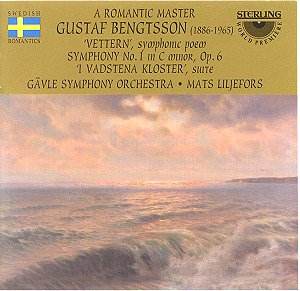Gustaf BENGTSSON (1886-1965)
'Vettern' Symphonic Poem
Symphony No. 1 in C minor
'I Vadstena kloster' Three Tone Pictures for Orchestra
 Gävle Symphony Orchestra
conducted by Mats Liljefors
Gävle Symphony Orchestra
conducted by Mats Liljefors
 STERLING CDS-1008-2
[56:20]
STERLING CDS-1008-2
[56:20]

Swedish composer, Gustaf Bengtsson's music was more internationally inclined
than many of his contemporaries such as Stenhammar and Alfvén. He
learnt piano, violin and organ as a child and became a student at the
Conservatory of Music in Stockholm. He subsequently became a violinist in
the Royal Opera Orchestra and taught music, ultimately rising to become
headmaster of the municipal school of music at Linköping and was active,
in a leading capacity, in many performing organisations.
His 'Vettern' symphonic poem dates from 1949. It is a depiction
of life around a lake where he had lived all his life. There is no specific
programme but the music is pastoral, romantic, and dramatic and, one senses,
that it has nationalistic fervour. Bengtsson is best when being atmospheric
and evocative as in the misty beginning and in the pastoral pasasages elsewhere
he is less confident and the music sometimes teeters on the brink of bathos
and cliché. One senses he is occasionally reluctant to move on to
fresh episodes, lingering too long over weak material; but I am being somewhat
churlish here for there is music of merit to enjoy in this symphonic poem.
Bengtsson's Symphony No. 1 is a curious beast. If somebody put this
disc on and asked you to guess who wrote the music by listening to its first
movement, you would be really non-plussed. I thought I detected the styles
of Brahms, Schumann and even Eric Coates!
There is an appealing melody full of yearning and folk dance like material.
It is a movement that is both robust and fragile. The second movement could
have been written for a 1940s Hollywood woman's weepie; it's heart-on-sleeve
sentimental stuff. The finale mixes rather earnest material with lighter
dance-like melodies.
I Vadstena kloster is a collection of three tone poems each with a
liturgical connection. The first and longest, and most significant is I
klosterkyran. This is described as a 'completorium' (evening service)
and in it reference is made to an excerpt from Rosa rorans
bonitatem an antiphon, well known in Sweden, in praise of Saint Birgitta
by Bishop Nicolaus Hermanni of Linköping (c.1391). The antiphonal singing
is suggested by instrumental contrasts and solo phrases from, for example,
the viola and clarinet. When the motivic material is gathered together in
a more unified musical entity, it acquires a more hymn-like character that,
in turn, is enriched by a high degree of polyphonic writing. The result is
often sublime. The second movement, Meditation is something of an
incongruous anticlimax for in evoking a monk quietly meditating in a monastery
garden while singing is heard from a nearby church, the music practically
takes on the style of secular light music. The crass cuckoo calls don't help
the ecclesiastical/ pastoral atmosphere one bit either. The final Procession
is a depiction of a procession of monks and nuns through city streets where
they dispense alms to the poor. One gets the impression from his bassoon
figures that Bengtsson might be suggesting that some of them are portly and
bumptious as well as proud and solemn.
An off-the-beaten-track collection. The curious and adventurous may find
it worth a visit
Reviewer
Ian Lace

and another view from Rob Barnett
Bengtsson's Wagnerian late-romantic music here receives not only justice
but convinced advocacy. As with all these Sterling enterprises Bo Hyttner's
creative judgement is spot on.
Oddly enough Bengtsson's name is not one I had come across in days when I
was exploring the Scandinavian repertoire with tape enthusiasts back in the
1980s. I came to this disc not knowing what to expect.
Vettern is Bengtsson's mood picture of Lake Vattern near Vadstena. It is
the location of the composer's holiday home where he wrote most of his music.
Old-fashioned it certainly was for 1949 but its hyper-romanticism and
nationalistic spirit are triumphantly conjured up. It is often in the quieter
moments as in the gentle wave 'crashes' (11.50 - 12.22) that Bengtsson's
muse speaks with greatest poetic accomplishment.
The symphony (the first of three - will Sterling give us the other two?)
is quite compact. It is not at all one of those overblown late-romantic
ramshackle structures we might (a little unworthily) associate with Respighi,
Paderewski, Farwell (have you ever heard his Arthur Gott Symphony? - perhaps
a candidate for Naxos US Classics series), Karlowicz or Noskowski.
The influences to be found in Bengtsson music are Tchaikovsky (somewhat watered
in terms of passion) and Peterson-Berger. In the adagio a Tchaikovskian
element is prominent as well as a peppering of Rachmaninov (Symphony No.
2). The allegro vivace is a brusque fantasy set off by some Sibelian
woodwind, Tchaikovskian language (Voyevode, Hamlet) all softened
by a Swedish tunefulness. Ludolf Nielsen's orchestral suites might be a Danish
parallel.
The suite is a set of relaxed meditations - countrified, pastoral and smilingly
gracious-spirited. In the middle movement I thought of Sibelius's more unbuttoned
incidental music. The pizzicato playing is delicately accented and there
is some notably turned quiet music in the last movement..
The tone of the music is uncannily echoed by the luminous sea-scape painting
featured on the cover. The artist is Carl Wilhelm Jaensson.
The suite is on CD for the first time.
That this disc exists at all we owe to the financial support of the Swedish
National Council for Cultural Affairs. Another silver arrow in the Sterling
quiver!
Reviewer
Rob Barnett


![]()